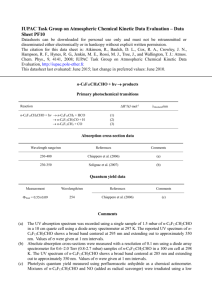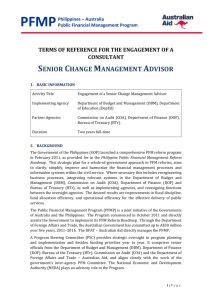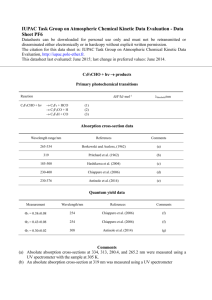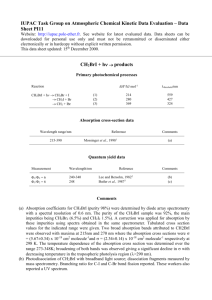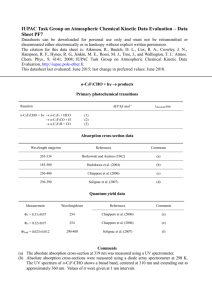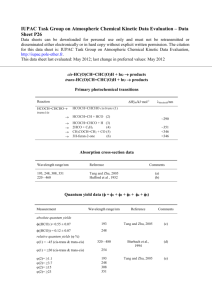Photolysis Study of Perfluoro-2-methyl-3
advertisement
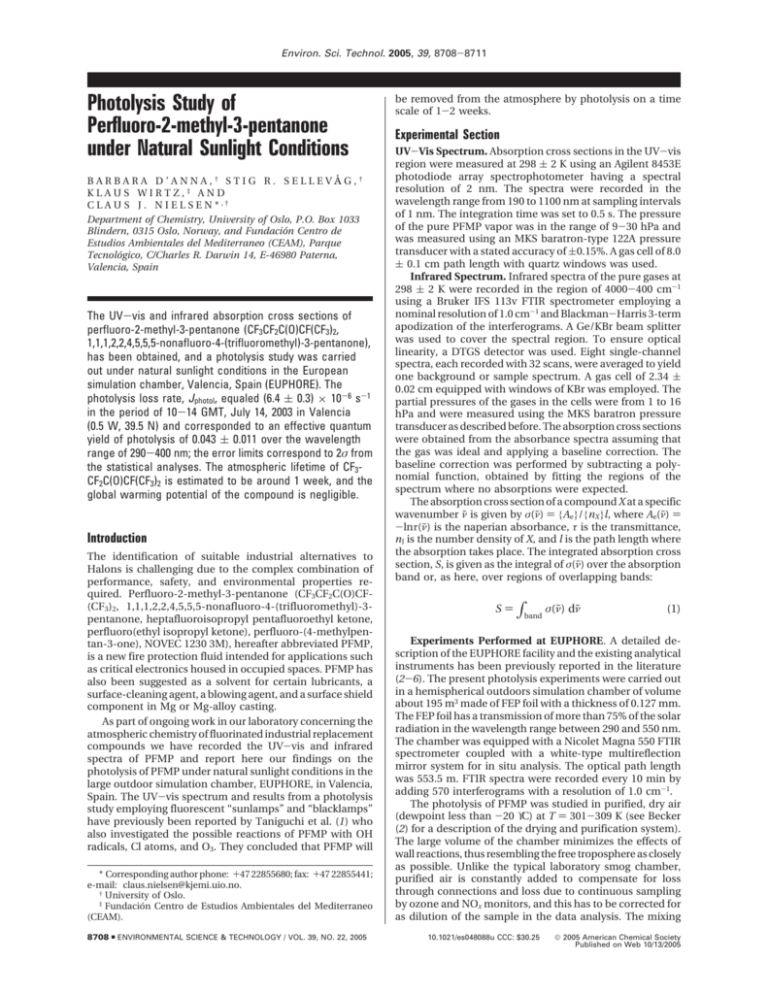
Environ. Sci. Technol. 2005, 39, 8708-8711
Photolysis Study of
Perfluoro-2-methyl-3-pentanone
under Natural Sunlight Conditions
BARBARA D’ANNA,† STIG R. SELLEVÅG,†
KLAUS WIRTZ,‡ AND
C L A U S J . N I E L S E N * ,†
Department of Chemistry, University of Oslo, P.O. Box 1033
Blindern, 0315 Oslo, Norway, and Fundación Centro de
Estudios Ambientales del Mediterraneo (CEAM), Parque
Tecnológico, C/Charles R. Darwin 14, E-46980 Paterna,
Valencia, Spain
The UV-vis and infrared absorption cross sections of
perfluoro-2-methyl-3-pentanone (CF3CF2C(O)CF(CF3)2,
1,1,1,2,2,4,5,5,5-nonafluoro-4-(trifluoromethyl)-3-pentanone),
has been obtained, and a photolysis study was carried
out under natural sunlight conditions in the European
simulation chamber, Valencia, Spain (EUPHORE). The
photolysis loss rate, Jphotol, equaled (6.4 ( 0.3) × 10-6 s-1
in the period of 10-14 GMT, July 14, 2003 in Valencia
(0.5 W, 39.5 N) and corresponded to an effective quantum
yield of photolysis of 0.043 ( 0.011 over the wavelength
range of 290-400 nm; the error limits correspond to 2σ from
the statistical analyses. The atmospheric lifetime of CF3CF2C(O)CF(CF3)2 is estimated to be around 1 week, and the
global warming potential of the compound is negligible.
Introduction
The identification of suitable industrial alternatives to
Halons is challenging due to the complex combination of
performance, safety, and environmental properties required. Perfluoro-2-methyl-3-pentanone (CF3CF2C(O)CF(CF3)2, 1,1,1,2,2,4,5,5,5-nonafluoro-4-(trifluoromethyl)-3pentanone, heptafluoroisopropyl pentafluoroethyl ketone,
perfluoro(ethyl isopropyl ketone), perfluoro-(4-methylpentan-3-one), NOVEC 1230 3M), hereafter abbreviated PFMP,
is a new fire protection fluid intended for applications such
as critical electronics housed in occupied spaces. PFMP has
also been suggested as a solvent for certain lubricants, a
surface-cleaning agent, a blowing agent, and a surface shield
component in Mg or Mg-alloy casting.
As part of ongoing work in our laboratory concerning the
atmospheric chemistry of fluorinated industrial replacement
compounds we have recorded the UV-vis and infrared
spectra of PFMP and report here our findings on the
photolysis of PFMP under natural sunlight conditions in the
large outdoor simulation chamber, EUPHORE, in Valencia,
Spain. The UV-vis spectrum and results from a photolysis
study employing fluorescent “sunlamps” and “blacklamps”
have previously been reported by Taniguchi et al. (1) who
also investigated the possible reactions of PFMP with OH
radicals, Cl atoms, and O3. They concluded that PFMP will
* Corresponding author phone: +47 22855680; fax: +47 22855441;
e-mail: claus.nielsen@kjemi.uio.no.
† University of Oslo.
‡ Fundación Centro de Estudios Ambientales del Mediterraneo
(CEAM).
8708
9
ENVIRONMENTAL SCIENCE & TECHNOLOGY / VOL. 39, NO. 22, 2005
be removed from the atmosphere by photolysis on a time
scale of 1-2 weeks.
Experimental Section
UV-Vis Spectrum. Absorption cross sections in the UV-vis
region were measured at 298 ( 2 K using an Agilent 8453E
photodiode array spectrophotometer having a spectral
resolution of 2 nm. The spectra were recorded in the
wavelength range from 190 to 1100 nm at sampling intervals
of 1 nm. The integration time was set to 0.5 s. The pressure
of the pure PFMP vapor was in the range of 9-30 hPa and
was measured using an MKS baratron-type 122A pressure
transducer with a stated accuracy of (0.15%. A gas cell of 8.0
( 0.1 cm path length with quartz windows was used.
Infrared Spectrum. Infrared spectra of the pure gases at
298 ( 2 K were recorded in the region of 4000-400 cm-1
using a Bruker IFS 113v FTIR spectrometer employing a
nominal resolution of 1.0 cm-1 and Blackman-Harris 3-term
apodization of the interferograms. A Ge/KBr beam splitter
was used to cover the spectral region. To ensure optical
linearity, a DTGS detector was used. Eight single-channel
spectra, each recorded with 32 scans, were averaged to yield
one background or sample spectrum. A gas cell of 2.34 (
0.02 cm equipped with windows of KBr was employed. The
partial pressures of the gases in the cells were from 1 to 16
hPa and were measured using the MKS baratron pressure
transducer as described before. The absorption cross sections
were obtained from the absorbance spectra assuming that
the gas was ideal and applying a baseline correction. The
baseline correction was performed by subtracting a polynomial function, obtained by fitting the regions of the
spectrum where no absorptions were expected.
The absorption cross section of a compound X at a specific
wavenumber ν̃ is given by σ(ν̃) ) {Ae}/{nX}l, where Ae(ν̃) )
-lnτ(ν̃) is the naperian absorbance, τ is the transmittance,
nJ is the number density of X, and l is the path length where
the absorption takes place. The integrated absorption cross
section, S, is given as the integral of σ(ν̃) over the absorption
band or, as here, over regions of overlapping bands:
S)
∫
band
σ(ν̃) dν̃
(1)
Experiments Performed at EUPHORE. A detailed description of the EUPHORE facility and the existing analytical
instruments has been previously reported in the literature
(2-6). The present photolysis experiments were carried out
in a hemispherical outdoors simulation chamber of volume
about 195 m3 made of FEP foil with a thickness of 0.127 mm.
The FEP foil has a transmission of more than 75% of the solar
radiation in the wavelength range between 290 and 550 nm.
The chamber was equipped with a Nicolet Magna 550 FTIR
spectrometer coupled with a white-type multireflection
mirror system for in situ analysis. The optical path length
was 553.5 m. FTIR spectra were recorded every 10 min by
adding 570 interferograms with a resolution of 1.0 cm-1.
The photolysis of PFMP was studied in purified, dry air
(dewpoint less than -20 °C) at T ) 301-309 K (see Becker
(2) for a description of the drying and purification system).
The large volume of the chamber minimizes the effects of
wall reactions, thus resembling the free troposphere as closely
as possible. Unlike the typical laboratory smog chamber,
purified air is constantly added to compensate for loss
through connections and loss due to continuous sampling
by ozone and NOx monitors, and this has to be corrected for
as dilution of the sample in the data analysis. The mixing
10.1021/es048088u CCC: $30.25
2005 American Chemical Society
Published on Web 10/13/2005
FIGURE 1. UV absorption cross sections of PFMP, 1,1,1,2,2,4,5,5,5nonafluoro-4-(trifluoromethyl)-3-pentanone (full curve), and 2-pentanone (dashed curve). (b) Data from Taniguchi et al. (1). Dotted
curve: actinic flux in the chamber at 15:20 (solar time).
ratio of PFMP in the chamber was initially ca. 1 ppm, and
it may be reduced by photolysis (2) and dilution (3) as
homogeneous gas-phase reactions do not play any role in
the atmospheric loss (1).
PFMP + hν f Products
PFMP f Loss by sampling
Jobs
(2)
kdilution
(3)
Approximately 20 ppb of SF6 was added to the reaction
chamber to determine the overall dilution rate coefficient,
kdilution:
SF6 f Loss by sampling
kdilution
ln{[SF6]0/[SF6]t} ) kdilutiont
(4)
(5)
where [SF6]0 and [SF6]t are the initial SF6 concentration and
that after a time t, respectively.
Thus, the apparent photolysis rate coefficient of PFMP,
Jobs, can be obtained from the expression:
ln{[PFMP]0}/{[PFMP]t} ) (kdilution + Jobs)t
(6)
The effective quantum yield for the photolysis of the
compound under study can be calculated according to the
following expression:
Φeff ) Jobs/Jmax
(7)
where the maximum photolysis rate coefficient, Jmax, is given
by:
Jmax )
∫σ(λ)F(λ) dλ
(8)
Here σ(λ) is the absorption cross section (base e) of the
compound in units of cm2 molecule-1 and F(λ) is the solar
actinic flux (photons cm-2 s-1). The actinic flux was measured
by a Bentham DM300 spectroradiometer as recently described by Wenger et al. (6), and the integration was carried
out over the wavelength range of 290-400 nm.
Results and Discussion
UV-Vis Absorption Cross Section. The UV-vis absorption
cross section of PFMP at 298 ( 2 K was determined by a
least-squares fit of the data from three independent measurements in pure gas at different pressures. The obtained
UV-vis absorption cross section (base e) is shown in Figure
1 (the absorption cross section is available in JCAMP format
as Supporting Information). The absorption band corresponds to the weak π* r n transition of the carbonyl group.
When systematic errors in pressure measurements, temperature, optical path length, and instrumental drift are added
FIGURE 2. Infrared absorption cross section of PFMP (1,1,1,2,2,4,5,5,5nonafluoro-4-(trifluoromethyl)-3-pentanone) overlaid by the ν3(F1u)
band of SF6.
to the 2σ error from the least-squares fit (0.6%), it is estimated
that the absolute error limit of the integrated cross section
is approximately 2%. For comparison, Figure 1 includes the
recently published data by Taniguchi et al. (1) and the UV
spectrum of 2-pentanone (7), CH3C(O)CH2CH2CH3, which is
the only other ketone studied under similar conditions in
the EUPHORE reactor (8). It is apparent that (i) the agreement
between the two UV-vis data sets for PFMP is better than
5% in the region around the absorption maximum, (ii) the
fluorinated ketone, PFMP, absorbs between 240 and 350 nm
with a maximum around 305 nm and with an integrated
absorption cross section apparently slightly larger than that
of 2-pentanone (7), and (iii) the intensity maximum is redshifted ca. 26 nm obviously caused by the electronegative
substitutents in the R,R′-positions in analogy with the
situation in fluorinated propanones (9).
Infrared Absorption Cross Section. The integrated cross
section of the absorption bands were determined by plotting
the integrated absorbance against the product of the number
density and the path length. None of the regression lines had
a y-intercept significantly different from zero. A least-squares
method that forced the regression line through zero was
therefore used to determine the absorption intensities.
Quantified systematic errors are pressure measurements
(0.15%), path length (0.90%), and temperature (0.67%). The
IR absorption cross section (base e) of PFMP is shown in
Figure 2 (the IR absorption cross section is available in JCAMP
format as Supporting Information). The integrated absorption
cross section over the 1880-480 wavenumber region is (40.5
( 0.8) × 10-17 cm molecule-1; the estimated uncertainty in
the total absorption cross section of PFMP includes the
additional 2σ error from the least-squares fit (0.7%) to the
above-mentioned systematic errors.
We use the absorption cross section of HCFC-22, which
has been critically evaluated by Ballard et al. (10), as a
benchmark. Our measurements of HCFC-22 are constantly
within 5% of the absorption intensities reported by Ballard
and co-workers. In recent studies of a series fluorinated
compounds (11-13), we demonstrated excellent agreement
with previous results for the infrared cross sections. We
therefore believe that our measurements of PFMP are not
affected by any large systematic errors.
Effective Quantum Yield of Photolysis. A photolysis
experiment with PFMP was carried out at the EUPHORE
simulation chamber in Valencia, Spain (0.5 W, 39.5 N) during
the month of July 2003. The removal of SF6 and PFMP from
the chamber was monitored by FTIR. The concentration of
SF6 was determined from the integrated intensity of the ν3(F1u) band around 947.5 cm-1, which does not overlap the
PFMP absorption bands (see Figure 2). The relative concentrations of PFMP were determined by a spectral subtraction procedure involving the initial PFMP spectrum and a
reference spectrum of water and limited to the carbonylVOL. 39, NO. 22, 2005 / ENVIRONMENTAL SCIENCE & TECHNOLOGY
9
8709
FIGURE 3. Plot of ln{[SF6]0/[SF6]t} vs time, showing the mass loss
from the reactor (Teflon) to the surrounding: (b) uncorrected data;
(O) data corrected for changes in (P, T) during the experiment.
FIGURE 4. Plot of ln{[PFMP]0/[PFMP]t} vs time, showing the total
loss from the reactor (Teflon) during photolysis: (b) uncorrected
data; (O) data corrected for changes in (P, T) during the experiment.
stretching band (1820-1760 cm-1); the carbonyl-stretching
bands of the photolysis products CF2O and CF3CFO both fall
at higher wavenumbers and do not overlap this band (1).
The pressure and the temperature inside the chamber were
not constant during the experiment. The observed reductions
in SF6 and PFMP concentrations were therefore corrected
according to the changes in pressure and temperature using
the ideal gas lawsthe corrections being less than 1.5%. From
a least-squares analysis of the decay in SF6 concentration
(Figure 3), the dilution rate coefficient during the photolysis
experiment was found to be (6.15 ( 0.16) × 10-6 s-1 (2σ).
Figure 4 presents the simultaneous decay of the PFMP
concentration given as a plot of ln{[PFMP]0/[PFMP]t} versus
the photolysis time, from which the total removal rate
coefficient of PFMP was determined to be (1.258 ( 0.013) ×
10-5 s-1 (2σ)sin 3 h around 13% of PFMP was removed from
the reactor. The data obtained (Figures 2 and 3) indicate that
the total reduction in PFMP concentration during midday
conditions in July was about twice the reduction in concentration of the inert tracer, SF6. As there are no other known
loss processes, the effective photolysis rate is found by
correcting for dilution giving a value for Jobs of (6.4 ( 0.3) ×
10-6 s-1 (2σ) at July 14 in Valencia 2003. This corresponds to
a lifetime of 44 h under conditions of atmospheric pressure
with ⟨JNO2⟩ ) 7.85 × 10-3 s-1. A conservative estimate of the
atmospheric lifetime of PFMP with respect to photolysis is
around 1 week. For comparison, Taniguchi et al. (1) estimated
8710
9
ENVIRONMENTAL SCIENCE & TECHNOLOGY / VOL. 39, NO. 22, 2005
FIGURE 5. Plot of the calculated maximal photolysis rates, Jmax, of
PFMP (1,1,1,2,2,4,5,5,5-nonafluoro-4-(trifluoromethyl)-3-pentanone,
CF3CF2-C(O)-CF(CF3)2) (b) and 2-pentanone, CH3-C(O)-CH2CH2CH3 (O) vs time of day (GMT solar) assuming a uniform quantum
efficiency. The UV-vis data for 2-pentanone are taken from ref 7.
the atmospheric photolysis lifetime of PFMP to be between
1 and 2 weeks from laboratory studies employing sunlamps.
Although the integrated absorption cross section of PFMP is
large, the short atmospheric lifetime makes the global
warming potential of the compound negligible.
The maximum photolysis rate coefficient, Jmax (see eq 8),
during the experiment is shown in Figure 5, which also
includes Jmax for 2-pentanone for comparisonsthe only
related ketone studied under similar conditions (8). Jmax for
PFMP varies between 1.24 and 1.57 × 10-4 s-1 with a time
average during the experiment of 1.49 × 10-4 s-1. The
observed photolysis rate therefore corresponds to an effective
quantum efficiency of photolysis under tropospheric sunlight
conditions of Φeff ) 0.043 ( 0.011 (2σ), which compares to
0.07 ( 0.1 for 2-pentanone (8). As shown by Taniguchi et al.
(1) nonradiative (collision assisted) relaxation processes are
extremely effective following the initial S0 f S1 excitation.
However, an effective fluorescence via the S1 f S0 transition
similar to the situation in CF3CHO (11) cannot be ruled out.
Acknowledgments
This work is part of the project “Impact of Fluorinated
Alcohols and Ethers on the Environment” (IAFAEE) and has
received support from the CEC Environment and Climate
program through Contract ENVK2-1999-00099. Fundación
CEAM is supported by Generalidad Valenciana and Fundación Bancaixa.
Supporting Information Available
UV-vis and infrared absorption cross sections of 1,1,1,2,2,4,5,5,5-nonafluoro-4-(trifluoromethyl)-3-pentanone in JCAMP
format. This material is available free of charge via the Internet
at http://pubs.acs.org.
Literature Cited
(1) Taniguchi, N.; Wallington, T. J.; Hurley, M. D.; Guschin, A. G.;
Molina, L. T.; Molina, M. J. Atmospheric chemistry of C2F5C(O)CF(CF3)2: photolysis and reaction with Cl atoms, OH radicals,
and ozone. J. Phys. Chem. A 2003, 107, 2674-2679.
(2) Becker, K. H. The European Photoreactor EUPHORE; Final Report
of the EC Project, Contract EV5V-CT92-0059: Wuppertal,
Germany, 1996.
(3) Magneron, I.; Thevenet, R.; Mellouki, A.; Le Bras, G.; Moortgat,
G. K.; Wirtz, K. A study of the photolysis and OH-initiated
oxidation of acrolein and trans-crotonaldehyde. J. Phys. Chem.
A 2002, 106, 2526-2537.
(4) Volkamer, R.; Platt, U.; Wirtz, K. Primary and secondary glyoxal
formation from aromatics: Experimental evidence for the
bicycloalkyl-radical pathway from benzene, toluene, and pxylene. J. Phys. Chem. A 2001, 105, 7865-7874.
(5) Klotz, B.; Sorensen, S.; Barnes, I.; Becker, K. H.; Etzkorn, T.;
Volkamer, R.; Platt, U.; Wirtz, K.; Martin-Reviejo, M. Atmospheric
oxidation of toluene in a large-volume outdoor photoreactor:
In situ determination of ring-retaining product yields. J. Phys.
Chem. A 1998, 102, 10289-10299.
(6) Wenger, J. C.; Le Calve, S.; Sidebottom, H. W.; Wirtz, K.; Reviejo,
M. M.; Franklin, J. A. Photolysis of chloral under atmospheric
conditions. Environ. Sci. Technol. 2004, 38, 831-837.
(7) Martinez, R. D.; Buitrago, A. A.; Howell, N. W.; Hearn, C. H.;
Joens, J. A. The near UV absorption-spectra of several aliphaticaldehydes and ketones at 300-K. Atmos. Environ., Part A 1992,
26, 785-792.
(8) Moortgat, G. K. Evaluation of Radical Sources in Atmospheric
Chemistry through Chamber and Laboratory Studies: RADICAL;
Max-Planck-Institut für Chemie, Atmospheric Chemistry Division: 2000.
(9) Metcalfe, J.; Phillips, D. Photophysical processes in fluorinated
acetones. J. Chem. Soc., Faraday Trans. 2, 1976, 72, 1574-1583.
(10) Ballard, J.; Knight, R. J.; Newnham, D. A.; Vander Auwera, J.;
Herman, M.; Di Lonardo, G.; Masciarelli, G.; Nicolaisen, F. M.;
Beukes, J. A.; Christensen, L. K.; McPheat, R.; Duxbury, G.;
Freckleton, R.; Shine, K. P. An intercomparison of laboratory
measurements of absorption cross-sections and integrated
absorption intensities for HCFC-22. J. Quant. Spectrosc. Radiat.
Transfer 2000, 66, 109-128.
(11) Sellevåg, S. R.; Kelly, T.; Sidebottom, H.; Nielsen, C. J. A study
of the IR and UV-vis absorption cross-sections, photolysis and
OH-initiated oxidation of CF3CHO and CF3CH2CHO. Phys.
Chem. Chem. Phys. 2004, 6, 1243-1252.
(12) Oyaro, N.; Sellevåg, S. R.; Nielsen, C. J. A study of the OH and
Cl-initiated oxidation, IR absorption cross-section, radiative
forcing and global warming potential of four C4-hydrofluoroethers. Environ. Sci. Technol. 2004, 38, 5567-5576.
(13) Oyaro, N.; Sellevåg, S. R.; Nielsen, C. J. Atmospheric chemistry
of hydrofluoroethers: Reaction of a series of hydrofluoroethers
with OH radicals and Cl atoms, atmospheric lifetimes, and global
warming potentials. J. Phys. Chem. A 2005, 109, 337-346.
Received for review December 3, 2004. Revised manuscript
received August 15, 2005. Accepted September 13, 2005.
ES048088U
VOL. 39, NO. 22, 2005 / ENVIRONMENTAL SCIENCE & TECHNOLOGY
9
8711
